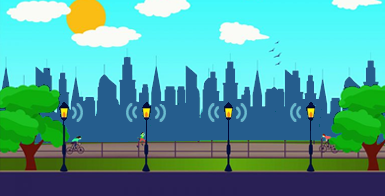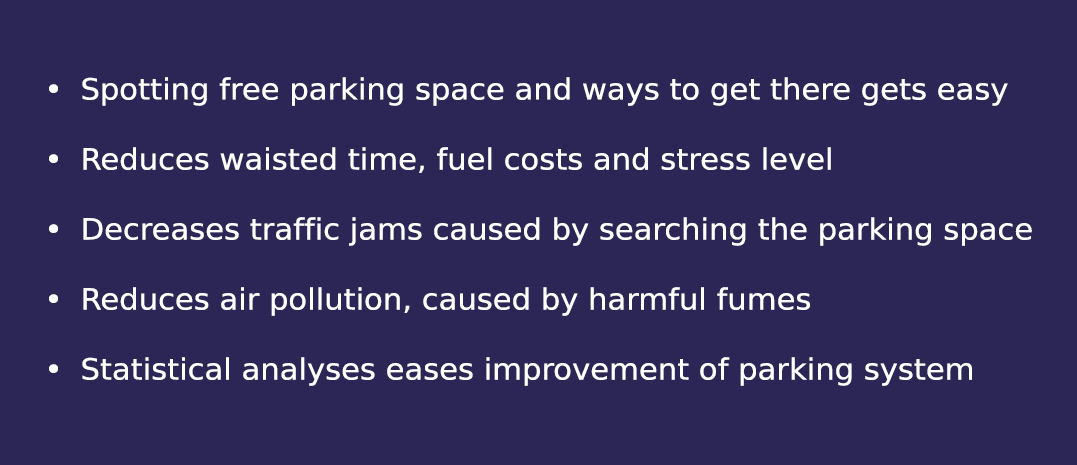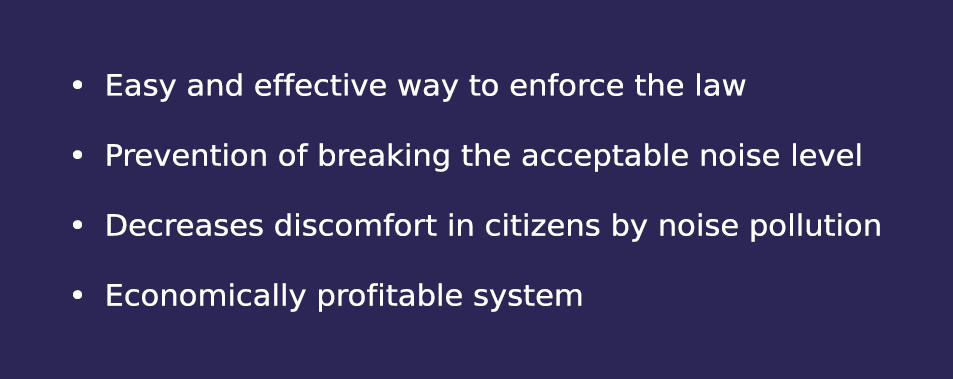
Smart city concept assumes maintaining and managing city assets efficiently with the help of digital technologies. It integrates different type of connected electronic sensors and devices (Internet of Things) with information and telecommunication technologies to automate community services, connect to citizens and provide optimization of city operations.
The goal of Smart Cities is to enhance quality, performance and interactivity of urban services that improve quality of life for citizens and visitors. Sensors, networks and specialized software applications are installed in orders to assist city governments to manage street lightings, energy and water supplies, waste collection, parking, and environment, improve urban flows and allow real-time responses.
Nexy Tech is committed to supporting the development of Smart Cities in Georgia by offering various modern technological solutions, software and services.
With the partnership of world leading companies, we provide our customers with the opportunity not only to implement advanced technological solutions but also introduce best management practices to ensure efficient and flawless operations and better services to the citizens.
SMART STREET LIGHTING

The efficiency of street lights using modern technologies is improving on a daily basis and is becoming more comfortable for the urban population.
Nowadays most of the cities, parks and public places in Georgia use old fashioned lightbulbs, which consume a lot of electric power. They are efficient for illuminating but lack smart control measures for monitoring. Handling this kind of electric light is also very uncomfortable for City Service companies as they have difficulties in monitoring the streetlights maintenance process. It is impossible to monitor every lightbulb in the city using the old system, check whether they are in working conditions, and managed them individually. Therefore, sometimes malfunctioned electric lights stay dark at night for several days, and citizens used to contact service companies themselves to report the problem, which is uncomfortable for everyone.
SOLUTION DESCRIPTION
World leading countries are using smart street lighting to solve this problem. Old type lightbulbs are replaced by LED lighting (this process has already started in Tbilisi). Remote controllers and other sensory equipment (light and motion sensors) are installed together with lightbulb. Controllers give us information about the state of the electric light, and it is easy to manage them on an individual level. In addition, the controllers can act automatically based on information got from light and motion sensors.
As an example, lights can be turned on when there is a specific level of darkness reached, when streets get darker lights get brighter. In specific areas of the city lights can get brighter if there is more motion in the streets and become less bright if there is no motion.
Inclusion into the wireless data network gives the possibility to manage lights remotely. The special software platform developed specifically for the street lighting service will enable to share the data.
BENEFITS

Based on analyses from different countries, smart outdoor LED lighting system increases the energy efficiency by 20%-30%. Using the smart lighting system as they are dimmed to lower light while being unnecessary, beside saving the electrical power, is also very effective for the environment as they emit far less carbon dioxide, resulting in less pollution.
In addition, discomfort caused by bulb damage is decreased as smart lighting system constantly controls the daily condition of the bulb. In case of urgency or any other extraordinary cases immediately informs respective city service centers that in its turn considerably decreases the servicing labor cost. Besides minimizing the costs, smart street lighting can cause increase of the profit for the city. This can be achieved by new opportunities to advertise digitally on the light post, by adding chargers for electric cars and scooters or by other modern ways.
SMART PARKING

Smart Parking system is modern city’s one of the answers to solving parking problem. The solution makes it easy and comfortable to search for free parking space and direct drivers towards the destination in the shortest way.
Nowadays parking becomes more and more problematic. Drivers waste a lot of time and energy in searching for free parking spots. Doing so, they often cause traffic jams and slow down car passage, which gets unbearable during rush hours. In addition, cars also use more fuel resulting in environment pollution.
After a lot of search citizens tend to park cars far from the desired destination or leave their cars at improper places, like sidewalks that causes discomfort for pedestrians.
SOLUTION DESCRIPTION
Smart parking system enables the driver to get the information on the smartphone upon availability of free parking spots and the optimal access route to get there.
Solution considers placing magnetic and radar sensors on the parking spaces. They will get information if parking spot is free or occupied. Given sensors endure cars weight and have up to 10-year guarantee of autonomous work. Parking sensors transmit the information via low power wide area radio network about their status to the control center, that in its turn ensures to place the information on a map. As a result, the driver gets optimal routes to the desired destination.
BENEFITS

Using the Smart Parking system saves drivers time, energy and fuel cost. The amount of people that are fined due to parking in the wrong places will be minimized. In addition, the smart system will ease the stress received from searching the places without any result.
Timely search of parking spaces will help to avoid unnecessary traffic jams as well as slowing the car passage that will result in reducing the air pollution, caused by harmful fumes. The smart parking system will give possibility to the respective services to have access to the detailed statistics, analysis of which will give the possibility to manage the parking system better.
SMART WASTE MANAGEMENT

Modern cities smartness can be improved by implementing intelligent waste management system.
Problem lies in the lack of information about fullness of waste bin before the respective services see them on place, resulting in non-optimal way of managing the waste. Dumpster trucks are either coming to the overloaded garbage containers or to the empty ones. Doing it this way is not quite effective due to spent unnecessary fuel cost and human resources, not to say anything about additional traffic jams and air pollution. Citizen discomfort about contaminated conditions of the surroundings and noise caused by emptying the containers must also be taken into consideration.
This inefficiency is largely due to outdated manual collection methods and logistical processes which lack efficient data-driven solutions.
SOLUTION DESCRIPTION
Smart waste management considers installation of the specific sensors in the containers, that will measure fullness of the bin. Given information will be transferred via low power radio network technology (LPWAN) to the management center responsible for analyzing and planning the waste managing process.
This system can be used by central dispatchers as well as drivers of the truck can access the information using installed pad in the car or smartphone. They can get optimal directions and working instructions.
BENEFITS

Optimal way of picking up the trash can be achieved by using smart waste management system. This system gives possibility to timely empty the bins that decreases extra fullness of the containers and wasted runs by cars if the bins are not full enough. In result, the system causes considerable savings in fuel and other related costs. IoT applications reduce unnecessary empty runs and contribute to the reduction of traffic volume and pollutant emissions.
In addition, Citizens’ due to optimal scheduling of the trucks discomfort population feels is also brought to minimum, as they suffer less by noise, fumes emitted by trucks, unsanitary conditions and the heavy traffic.
SMART NOISE MONITORING

With the increase in population in the cities, increases environmental noise from vehicles or machinery, that is annoying, distracting, or physically harmful. The physical effects can include hearing problems, stress, and sleeplessness. Noise pollution is usually considered in terms of its effects on human populations, though it is known to affect wildlife as well, causing most of the cities to control the acceptable level of noise by law. As an example, physical or legal entity violating the permitted level of noise at a day or nighttime results in fining according to Georgian code of administrative violation.
Unfortunately, there are no effective ways to control previously stated problem in Georgia as determining the noise pollution level is inefficient by technical point of view. Urban population have to contact the police and inform them breaking of law repeatedly. Most of these cases the police is unable to identify violators.
SOLUTION DESCRIPTION
Smart sensor system of noise pollution will be installed in inhabited areas with recorded high level of noise in the city (bar areas and centric zones). Equipment will link one after another uniting at noise pollution detector network and will measure real time noise pollution. Therefore, when sound pollution continues over a period of time (minutes, hours), indicating violation of law, noise detector equipment transmits the data such as coordinates and other information to specialized programs using radio networks. Therefore, the police will get alerts and detailed information.
BENEFITS

Experience of World’s leading Cities’ proves that installation of the smart noise pollution monitoring system significantly improves the opportunities for controlling noisy areas. In addition, not only is maintaining acceptable level of noise effectively executed but citizens discomfort cause by noise pollution at night is also reduced.
Furthermore, Smart noise pollution monitoring network can bring profit, as their installment and operation cost is significantly small regarding to income that is accumulated by fining violations of law.
SMART BUS

In order to attract people to use public transport system government must make rides more comfortable and efficient. Buses with smart technologies is one part of this concept.
Detecting exact number of passengers in bus at specific period of time is hard, accordingly bus tours are planned with an assumption of travelers’ flow. Additionally, mechanisms for exposing stowaways is inefficient. These mechanisms imply fining of such people with the help of controllers.
Furthermore, public transport popularity decreases with inability to function optimally, causing population to travel with owned cars, provoking traffic jams.
SOLUTION DESCRIPTION
Special sensors are installed on the door of the bus, enabling computer vision mechanisms to see amount of ascending and descending passengers. The system detects the number of passengers in a day as well as number of passengers in a concrete time. The information transmits using radio networks to a central server, where existed Software application analyses the data. The information becomes available not only to transport service centers, but also to users of public transport.
BENEFITS

Smart bus is beneficial in many ways. As an example, passengers, waiting for the bus, can access the information of free sits on the upcoming bus using smartphone application. They have a chance to reflect on their choice if there are no sits available and choose different transportation.
The system creates opportunities for transport service center to access to varied analytic information. As an example, correlation between travelers and sold tickets creates an opportunity to identify violations and anomalies. The attention of bus controllers can be cast down to the places with most frequent stowaways. Real time monitoring grants opportunity to change bus action plan according to number of passengers to exclude overflow or empty buses.
